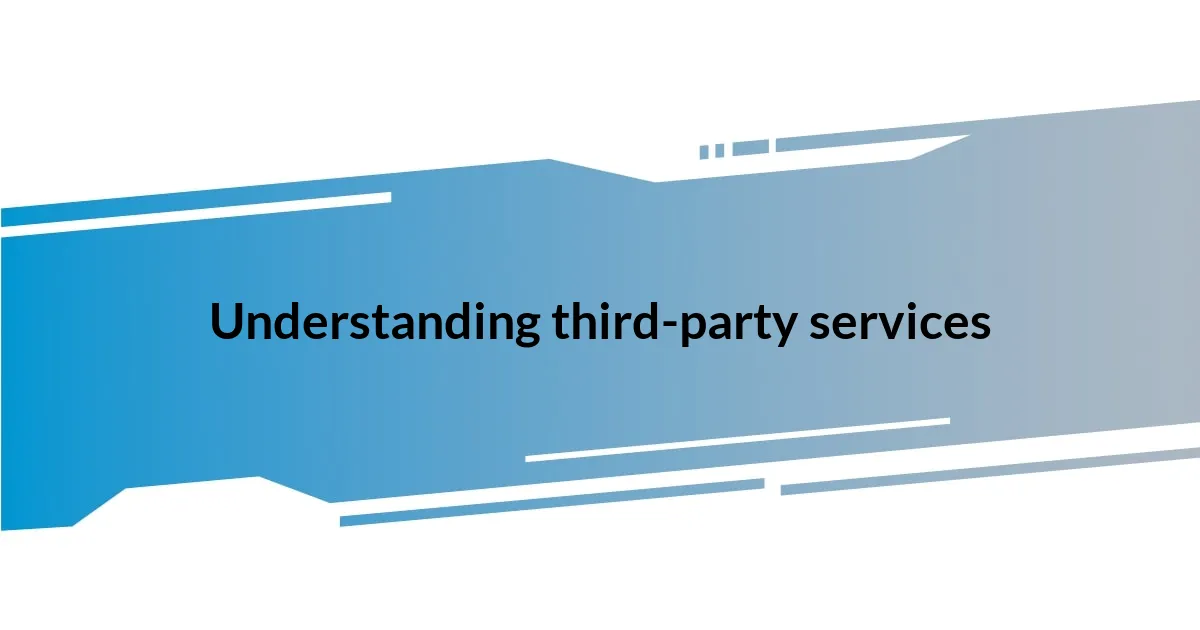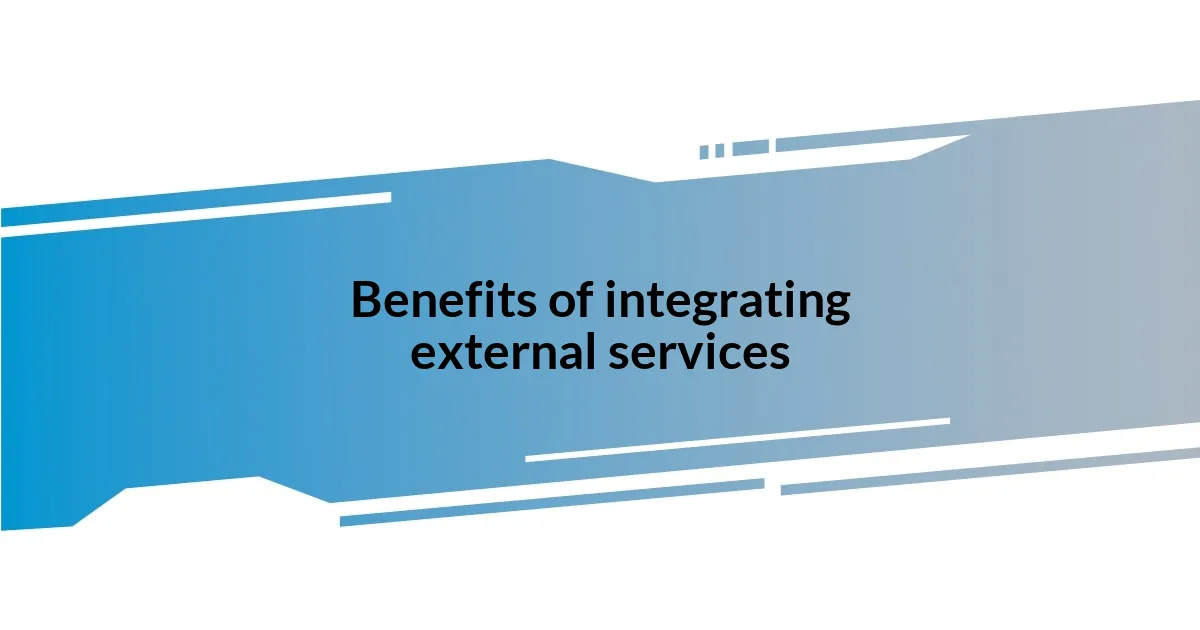Key takeaways:
- Integrating third-party services enhances business capabilities, improves efficiency, and allows focus on core business objectives.
- Challenges during integration include miscommunication, poor documentation, and data security concerns, all of which require thorough preparation and research.
- Success measurement involves tracking KPIs and gathering user feedback, guiding continuous improvement after integrations.
- Effective communication, realistic timelines, and adaptability are crucial for overcoming integration obstacles and ensuring successful collaborations.

Understanding third-party services
Third-party services can be a real game changer for businesses. I still remember the first time I integrated a payment processing service into my platform; it felt like a leap of faith. Suddenly, I could offer customers a smoother checkout experience, which not only simplified transactions but also boosted my sales—it’s incredible what the right tools can do.
It’s crucial to grasp that third-party services are essentially tools that enhance your capabilities without needing to build everything from scratch. Have you ever found yourself struggling with the technical side of things, wishing you had more hours in the day? I certainly have. Using APIs (Application Programming Interfaces) from third-party providers allowed me to focus on delivering value to my customers while experts handled the complexities behind the scenes.
While exploring these services, it’s worth reflecting on trust. How did I choose the right service for my business? I leaned heavily on user reviews and personal recommendations, which helped me feel confident in my decisions. Each integration felt like adding a new piece to a puzzle I was deeply invested in, transforming my operations one step at a time.

Benefits of integrating external services
Integrating external services has allowed me to unlock a level of efficiency I hadn’t anticipated. I remember when I added a customer relationship management (CRM) tool, and it was as if I had an extra pair of hands. Suddenly, tracking interactions and managing leads became seamless, reducing the chaotic whirlwind of keeping everything organized. This integration not only saved me time but also improved my relationships with clients—personalizing my outreach became easier, leading to better engagement and satisfaction.
Here are some tangible benefits of incorporating external services:
- Enhanced Functionality: Adding specialized services brings tools that elevate your platform’s capabilities beyond what you can build alone.
- Cost Efficiency: Leveraging established services can be more cost-effective than developing solutions in-house, freeing up resources for other areas.
- Rapid Deployment: Integrations often happen quickly, allowing you to react to market changes swiftly and effectively.
- Expertise at Hand: You gain access to the knowledge and skills of industry leaders, ensuring cutting-edge solutions without the steep learning curve.
- Focus on Core Business: By outsourcing certain functionalities, you can devote more time and energy to your primary goals, increasing overall productivity.
Each integration feels like a partnership with a trusted expert, allowing me to provide a richer experience for my customers without spreading myself too thin.

Challenges faced during integration
Integrating third-party services can sometimes feel like navigating a maze, filled with unforeseen obstacles. I vividly recall the frustration I faced when integrating a social media API; miscommunication about the version updates led to unexpected downtime. It wasn’t just a small hiccup—my customer engagement dropped, and I felt the weight of those missed connections pressing down on me.
One of the most insidious challenges is the varying quality of documentation provided by service vendors. I once spent hours sifting through ambiguous manuals that left me more confused than when I started. It’s disheartening, isn’t it? I had to reach out to customer support multiple times, only to receive answers that still left pieces of the puzzle missing. This kind of trial and error can lead to delays in project timelines and drive up costs unexpectedly.
Moreover, data security is a constant concern that looms over every integration. When I first integrated a third-party analytics tool, I had sleepless nights worrying about data breaches and compliance issues. The thought of compromising my customers’ information was enough to make me second-guess my decisions. Ensuring that the services I chose met the highest security standards required thorough research and sometimes, some intense conversations with the vendors.
| Challenge | Personal Experience |
|---|---|
| Miscommunication with APIs | Experienced unexpected downtime during social media API integration. |
| Poor Documentation | Struggled with ambiguous manuals, leading to delays and frustration. |
| Data Security Concerns | Felt anxious about data breaches during analytics tool integration. |

Key strategies for successful integration
When I think about key strategies for successful integration, one tactic stands out: thorough research before diving in. I learned the hard way that understanding the functionalities and compatibility of third-party services can save you from headaches later. For instance, during one project, I jumped into integrating a popular payment gateway without checking how it would align with my existing system. The mismatched requirements resulted in a frustrating delay that could have been easily avoided with a bit of diligence upfront.
Another critical strategy is maintaining open lines of communication with both your team and the service providers. I remember working closely with a third-party service during a complex integration, and regular check-ins were essential. These discussions not only clarified expectations but also helped quickly resolve issues. It’s amazing how a simple chat can turn a potential crisis into a manageable situation. Have you ever faced a pending deadline and thought that a short meeting could pave the way for quick solutions? I certainly have, and those conversations often make all the difference.
Lastly, don’t underestimate the power of testing and feedback post-integration. I once completed an integration without enough testing, only to find that it affected user experience negatively. That’s when I realized how crucial it is to gather feedback and iterate based on real user interactions. It’s like refining a recipe; sometimes, a pinch more of this and a dash less of that can elevate the entire dish. Embracing an agile mindset throughout the integration process ensures that you can adapt and enhance your systems effectively.

Tools that facilitate integration
Choosing the right tools to facilitate integration can be a game-changer. For instance, I discovered Zapier while exploring automation options. The moment I set it up, I felt a rush of relief as I watched systems communicate seamlessly, saving me countless hours that I could redirect toward more meaningful tasks. Have you ever experienced that joy of finding a perfect tool that simplifies your workflow? It’s like finding a key that unlocks a door you didn’t know was there.
Another tool that has greatly benefited my integration efforts is Postman. Initially, I was overwhelmed by the idea of testing APIs, but Postman made it incredibly intuitive. Picture this: I was able to send test requests and quickly visualize responses, which helped me troubleshoot issues on the fly. This tool not only reduced my anxiety during those tense integration phases but also significantly improved the overall quality of my work. It’s fascinating how the right tool can transform a daunting task into an engaging challenge.
Lastly, I can’t overlook the value of integration platforms like MuleSoft. My experience with it has been nothing short of enlightening. Integrating multiple systems felt like trying to connect dots in a grand picture, and MuleSoft provided the canvas. I learned how to utilize its features for data mapping and synchronization without compromising on security. It’s as if you’re piecing together a puzzle, and suddenly, the right platform allows all the fragments to come together beautifully. What tools have you found that help turn complex tasks into manageable ones? My journey has taught me that the choice of tools can make all the difference.

Measuring success of integration
Measuring the success of an integration isn’t just about checking off boxes; it’s a comprehensive evaluation of how well the new system enhances performance and user experience. I remember when I implemented a new customer relationship management (CRM) tool. Initially, I was solely focused on the technical aspects. However, it hit me that understanding user adoption rates and gathering detailed feedback were equally important indicators of success. Have you ever rolled out a new tool and wondered why team members hesitated to embrace it? That insight made me rethink how I approached each integration.
One effective way to gauge integration success is through tracking key performance indicators (KPIs). For example, after integrating an automated email marketing service, I monitored conversion rates and customer engagement closely. To my surprise, I noticed a significant uptick in responses within just a few weeks. It was exhilarating to see those numbers rise, affirming that the integration was having the desired impact. What metrics have you tracked that provided an unexpected glimpse into integration success?
Additionally, I learned the importance of post-integration reviews. In one instance, we conducted a thorough review after integrating a live chat feature on our website. The honest discussions revealed insights that, while uncomfortable at first, ultimately guided us toward meaningful improvements. Embracing these reflective moments can uncover hidden challenges and create a pathway for growth. How often do we take a moment to reflect on what went well and what didn’t? I find this practice vital for continuous improvement.

Lessons learned for future projects
Integrating third-party services taught me that clear communication is essential for successful collaboration. I once jumped into a project assuming everyone was on the same page, but quickly realized that misunderstandings could derail even the most straightforward tasks. Have you ever found yourself in a situation where clarity was lacking? By establishing frequent check-ins and encouraging open dialogue, I noticed a dramatic reduction in confusion and enhanced teamwork.
Another critical lesson I learned was the importance of setting realistic timelines. On one project, I ambitiously aimed to complete integration in record time. While my enthusiasm was commendable, the project proved more complex than anticipated. As deadlines loomed, the pressure mounted, leading to rushed decisions and overlooked details. From that experience, I now prioritize patience and a well-structured project timeline, which helps in managing expectations and ultimately leads to smoother integrations.
Lastly, I discovered that being adaptable is key in the world of integrations. Early in my journey, I encountered unexpected roadblocks that required quick pivots in strategy. One memorable instance involved a sudden change in API documentation that threw off my entire plan. Instead of feeling discouraged, I embraced the challenge and sought alternative solutions. This flexibility has not only allowed me to navigate issues more effectively but also to view each obstacle as a new opportunity for learning. Have you embraced adaptability in your projects? I truly believe that staying open-minded leads to significant breakthroughs.